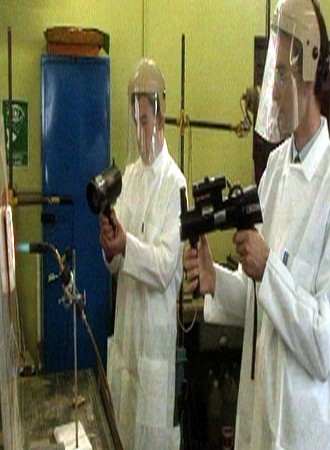
Monitoring the Peace (Arms Control Inspectors) 1999
Distributed by Chip Taylor Communications, 2 East View Drive, Derry, NH 03038-4812; 800-876-CHIP (2447)
Produced by Chip Taylor Communication
Director n/a
VHS, color, 30 min.
High School - Adult
Military Studies, History, Political Science
Date Entered: 11/09/2018
Reviewed by David Bertuca, Central Technical Services, and Science and Engineering Library, the University at Buffalo"Technology has transformed the way wars are fought. Peacekeepers and those who monitor peace treaties also use the same technology. It is now almost impossible for a nuclear test to go undetected, and chemical and biological weapons are much harder to hide. This program looks at the work of Arms Control inspectors and at some of the methods and technology they use."--Cover.
If you have ever wondered how UN inspectors can determine if a factory has been producing chemical weapons, or how nuclear explosions can be monitored, this videotape provides the answers. Monitoring the Peace discusses the history of modern peace efforts and ways that treaties and arms control policies are monitored. Some of the monitoring techniques shown include: location and destruction of land mines, nuclear test monitoring, satellite and aerial reconnaissance, computer-enhanced surveillance, and advanced scientific investigation of manufacturing facilities.
These modern technologies, weapons inventories, inspections, and other methods are used to reduce tensions between nations, to improve relations and communications, and to reduce the potential for conflict.
The videotape shows how the worldwide monitoring between nations occurs. Scenes show actual inspections, destruction of weapons, and surveillance. Specific examples of war and its effects are shown, such as arms inspection in Iraq showing sequences on conventional, nuclear, and chemical weapons production. The tape shows footage of inspections, describing how these inspections are conducted and the types of tests performed to detect the presence of chemicals or equipment used in producing various weapons. Also shown is actual footage of violations and attempts to remove evidence of illegal weapons production. Another segment of the videotape shows effects of various weapons on victims. Two examples provided show survivors of chemical weapons attacks in Iraq, and land mine victims in Africa. This and other segments connect the concepts of international arms control to the human aspect, along with its effects on individuals.
Overall, the tape is very good. The image quality is good, using graphics and animation to show the main point being discussed. Variation is good and the script is clearly understood. The material is well organized and shows how science and technological tools are used to identify arms production, weapons testing, monitoring of peace agreements, and the destruction of weapons to comply with arms reduction agreements